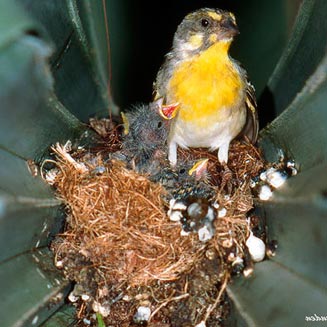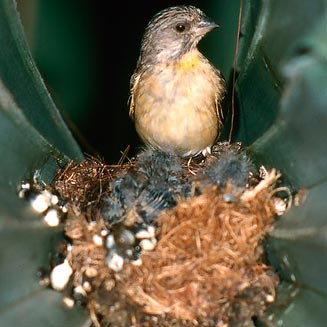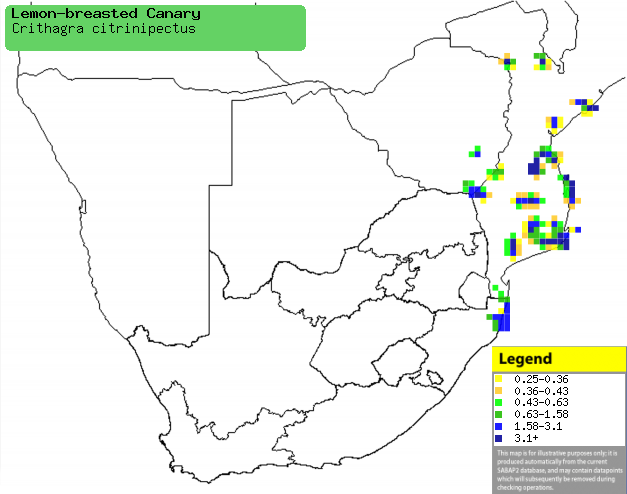|
Crithagra citrinipectus
(Lemon-breasted canary)
[= Serinus citrinipectus]
Geelborskanarie [Afrikaans]; Geelborstkanarie
[Dutch]; Serin à poitrine citron [French]; Gelbbrustgirlitz
[German]; Canário-de-peito-limão [Portuguese]
Life
> Eukaryotes >
Opisthokonta
> Metazoa (animals) >
Bilateria >
Deuterostomia > Chordata >
Craniata > Vertebrata (vertebrates) > Gnathostomata (jawed
vertebrates) > Teleostomi (teleost fish) > Osteichthyes (bony fish) > Class:
Sarcopterygii (lobe-finned
fish) > Stegocephalia (terrestrial
vertebrates) > Tetrapoda
(four-legged vertebrates) > Reptiliomorpha > Amniota >
Reptilia (reptiles) >
Romeriida > Diapsida > Archosauromorpha > Archosauria >
Dinosauria
(dinosaurs) > Saurischia > Theropoda (bipedal predatory dinosaurs) >
Coelurosauria > Maniraptora > Aves
(birds) >
Order: Passeriformes > Family: Fringillidae
 |
 |
| Lemon-breasted canary male, at nest with chicks. [photo
Hugh Chittenden ©] |
Lemon-breasted canary female, at nest with
chicks. [photo
Hugh Chittenden ©] |
For information about this species, see
birdinfo.co.za.
Distribution and habitat
Near-endemic to southern Africa, occurring from southern
Malawi to patches of Mozambique, extending into south-eastern Botswana and
north-eastern KwaZulu-Natal. Its distribution is strongly linked to that of the
Lala palm (Hyphaene coriacea), which it is dependent on for nest sites
and material (not food), so it mainly occupies Lala palm savanna and dry
woodland, sometimes moving into low-lying Mopane (Colosphermum mopane)
woodland, cultivated land and settlements in Zimbabwe.
|
 |
|
Distribution of Lemon-breasted canary in southern
Africa, based on statistical smoothing of the records from first SA Bird
Atlas Project (©
Animal Demography unit, University of
Cape Town; smoothing by Birgit Erni and Francesca Little). Colours range
from dark blue (most common) through to yellow (least common).
See here for the latest distribution
from the SABAP2. |
Food
It mainly eats seeds, doing most of its foraging on the
ground, sometimes taking food from grasses and other low vegetation.
Breeding
- Its breeding habits are not well known, however it is thought to be a
monogamous solitary nester.
- The nest (see images above) is a cup with a bulky foundation, made of
short plant fibres, especially from Lala palms (Hyphaene coriacea)
but occasionally with dead creeper stems, finely shredded bark, leaves and
dried flower petals as well. It is typically placed at the base of the 'V'
shape formed by a partly opened Lala palm frond, anywhere from about 1.5-7.0
metres above ground.
- Egg-laying season is from December-February.
- It usually lays three eggs, which are incubated solely by the female for
about 12-14 days (recorded in captivity).
- The chicks are mainly fed on a regurgitated seeds, leaving the nest
after approximately 14-16 days.
Threats
Not threatened internationally but Near-threatened
in South Africa, largely due to harvesting of Lala palms for palm wine and
basket-weaving material. It is estimated that up to 2000 birds are exported
annually from southern Mozambique for the cage-bird trade, which could have a
serious affect if continued.
References
-
Hockey PAR, Dean WRJ and Ryan PG 2005. Roberts
- Birds of southern Africa, VIIth ed. The Trustees of the John Voelcker
Bird Book Fund, Cape Town.
|
